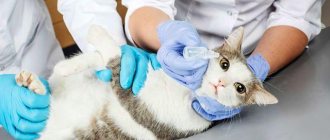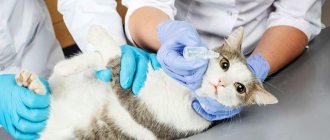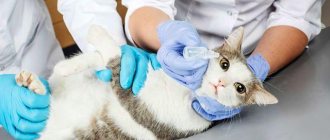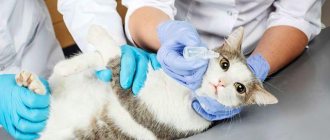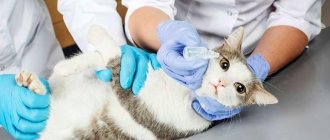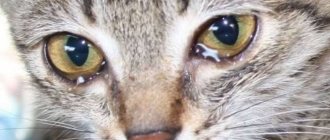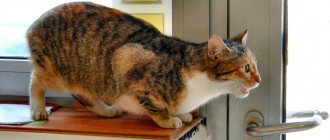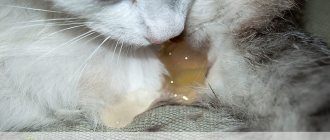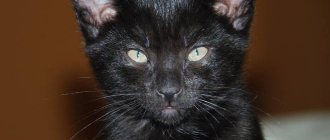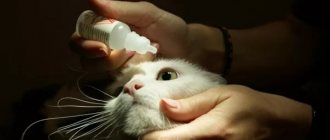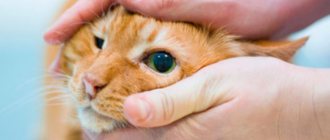Normally, cats always secrete a small amount of clear secretion from their eyes - it cleans the eyeballs of dust and foreign bodies. However, sometimes the color of the discharge takes on a brown tint. Then the cat will have unsightly marks and dark crusts under its eyes. Let's find out whether this is normal or pathological, and in what cases the help of a veterinarian is needed.
Cosmetic defect
Brown discharge from the corners of the eyes in cats is not always a sign of pathology. The cornea is constantly washed by tear fluid, but under certain circumstances it becomes larger.
The amount of discharge increases in strong winds, due to bright light, if the cat is in a dusty or smoky room.
The tear fluid contains substances that, when exposed to ultraviolet radiation, acquire a brownish tint. Dark discharge is most noticeable in the following cats:
- with light coat color;
- with a flattened muzzle;
- in older individuals;
- in emotional pets - when they purr, they produce copious amounts of tears or saliva.
Minor discharge, which over time turns into dried brown crusts, is not a pathology and does not threaten the cat in any way. This is just a cosmetic defect. Brown marks are usually removed using daily hygiene products.
Attention! You should not wipe your cat's eyes with hydrogen peroxide. If it comes into contact with the mucous membrane, the solution may cause irritation and discomfort.
Types of pathological discharge from the eyes
During pathological processes, cats develop discharge that differs in color and consistency:
- Transparent. If your cat's eyes are watery but a colorless liquid exudate is coming out, this may be a sign of an allergy.
- White or light yellow. Such discharge most often occurs due to a viral or fungal infection.
- Saturated yellow or greenish (purulent) is a sign of infection with pathogenic bacteria.
- Brown or reddish discharge with a thick consistency. This color indicates that they contain red blood cells.
Sources of disease
An infected person, an asymptomatic carrier of the disease, water or food can be a source of intestinal infections. Infection with a viral infection occurs through contact with another person, consumption of contaminated products, or use of shared hygiene products.
Many bacterial and viral intestinal infections are transmitted through dirty dishes, toys, household items and even a smartphone. At the same time, the causative agents of the disease are quite resistant to environmental factors - they can live on fruits and vegetables for weeks, and in water for months. Their favorite habitat is dairy, meat and fish products.
A pathogen such as Giardia cysts can live quietly in a humid external environment for up to 2 months or more. In this case, infection is possible by drinking unboiled water; contact with the carrier is not necessary.
Causes of discharge from eyes in cats
There are many reasons why a cat has brown discharge coming from its eyes. The problem can be caused by injury, infection, inflammation or even a tumor.
Impaired outflow of tear fluid
Dacryocystitis is one of the possible causes of bloody discharge in the corners of the eyes. This is a pathology in which the passage of tear fluid through the nasolacrimal duct becomes difficult.
The reasons for obstruction are as follows:
- Inflammation of the walls of the lacrimal canal, which leads to its narrowing and blockage. As a result, fluid stagnation occurs. A pathogenic microflora develops in the lacrimal sac, and a mucous secretion mixed with blood begins to be released from the corners. The inflammatory process is accompanied by redness of the eye and discomfort. The cat becomes restless.
- Narrowing of the lacrimal opening, or stenosis. This pathology occurs in cats, which often suffer from conjunctivitis. The chronic inflammatory process helps to reduce the diameter of the lacrimal opening. As a result, fluid constantly accumulates in the eye and flows out from the inner corner. Stenosis can be not only acquired, but also congenital. In this case, the problem can only be solved through surgery.
- Injury. During active play on the street or at home, cats sometimes bump into sharp objects and injure their eyes. When the eyelids are torn or cut, the tear duct often suffers. In this case, black discharge appears from the eye because the tear fluid contains a large amount of blood. It is important to seek help from a veterinarian immediately. If necessary, he will stitch the eyelid and help restore the patency of the nasolacrimal duct.
- Tumor. If the eye becomes less mobile and hurts, and brown tears flow from the corner, this may be caused by a benign or malignant neoplasm. The presence of blood in the tear fluid indicates tissue damage. Only surgery will help with the tumor. For eye cancer, treatment with chemotherapy is mandatory.
- Foreign body in the lacrimal canal. Motes such as grains of sand, dust particles, and insects can get into a cat's eyes. Together with tears, small foreign bodies sometimes penetrate the ducts of the nasolacrimal canal, which leads to its blockage and inflammation. The cat feels discomfort when blinking and tries to wash its eye with its paw. This causes even more irritation. Treatment involves removing the foreign body by washing or bougienage, as well as the use of local antiseptics.
Infectious diseases
Inflammation of the eyes, which is often accompanied by copious brown discharge, may be one of the symptoms of an infectious disease:
- chlamydia;
- toxoplasmosis;
- panleukopenia;
- calcivirosis;
- rhinotracheitis.
With such serious illnesses, the cat’s health deteriorates. She becomes lethargic, loses appetite, body temperature rises, and her coat looks unkempt. With some infectious diseases, kittens bleed not only from the eyes, but also from the nose. The eyelids become swollen and red.
Attention! If such symptoms are detected, you should immediately seek veterinary help. If left untreated, your cat may die from a viral infection.
Brown discharge also appears with ophthalmological diseases, which can be caused by a bacterial, viral or fungal infection. These include:
- conjunctivitis – inflammation of the mucous membrane of the eye;
- blepharitis – eyelash follicles are affected;
- keratitis – inflammation of the cornea;
- anterior uveitis - infection affects the blood vessels of the eyes.
In all of these cases, a sick cat may develop brown tears from one or both eyes if the inflammation has affected the vessels and capillaries.
Other pathologies
Cats sometimes have watery eyes due to problems with their internal organs. Diabetes mellitus, kidney, liver or intestinal diseases are often accompanied by brown discharge from the organs of vision. Also, a similar problem occurs when infected with helminths.
In rare cases, tearing occurs due to dietary errors, for example, when a cat owner feeds her dry and wet food at the same time.
In Sphynxes and Cornish Rexes there is such a pathology as entropion of the eyelid, in which brown discharge also flows from the eyes. Long-haired cats “cry” when hairs get on the mucous membrane of the eyeball.
Attention! Eyes can fester in any animal, regardless of their gender or age. However, cat breeds with a flattened face - Scottish, British and Persian - are especially susceptible to this pathology, because they have a shortened nasolacrimal duct.
Diagnostics
If the owner notices brown discharge around the cat's eyes, he needs to take the pet to a veterinary clinic. In most cases, examination and history is sufficient to make a diagnosis.
Sometimes it is necessary to conduct additional tests to help rule out head and eye injuries, as well as diseases of internal organs and infectious diseases. To do this you may need to do:
- Ultrasound of the organs of vision;
- X-ray of the skull;
- blood and stool tests.
Treatment and prevention
Depending on the cause of inflammation, the veterinarian develops a treatment regimen for the cat:
- In some cases, local therapy using drops or ointments with antimicrobial, analgesic and anti-inflammatory effects is sufficient.
- If brown discharge appears due to congenital pathology of the eyelids, surgery is recommended.
- Surgery cannot be avoided when a cat has an eye tumor.
- If the tear ducts are clogged or blocked, rinsing helps, but if they are narrowed, surgery may be necessary.
- If a kitten is diagnosed with an infectious disease, one of the symptoms of which is purulent eyes with brown discharge, then the pet is treated not only with eye drops, but with antiviral drugs and immunostimulants.
- For helminthiasis, which is accompanied by tearing, antiparasitic drugs are used.
Types of eye drops for cats
In most cases, treatment for brown discharge involves the use of topical eye medications. These include drops and ointments. They are divided into 3 groups - antimicrobial, antibacterial and antiviral (immunomodulatory).
Antiseptic drops
Antiseptics can be used for the prevention and treatment of ophthalmic diseases:
- Ophthalmosan. A preparation based on chlorhexidine and succinic acid. These components inhibit the development of pathogenic microflora. For brown discharge in cats, use 2-3 times a day, 2 drops under the lower eyelid. The duration of the course of treatment is determined by the veterinarian.
- Lacrican. The main component is the antiseptic polysept, which prevents the proliferation of microbes. The drug also contains anesthesin, a substance with an analgesic effect. After preliminary cleaning of brown discharge, 2 drops of medicine are injected under the cat’s lower eyelid. The procedure is carried out 2 or 3 times a day for 8–10 days.
Antibacterial drops
These are drugs that destroy gram-positive and gram-negative bacteria - chlamydia, mycoplasma, staphylococcus, Pseudomonas aeruginosa, etc. These microorganisms cause inflammation of the organs of vision, which is accompanied by purulent and brown discharge. List of medications for cats:
- Tsiprovet. It is prescribed for acute or chronic conjunctivitis, keratitis, blepharitis, and corneal ulcers. The active ingredient is ciprofloxacin. Directions for use and dosage for cats: 1 drop in each eye 4 times a day; the course of treatment for brown discharge is 1–2 weeks (until complete recovery).
- Dekta-2. The active ingredient here is gentamicin. It has a wide spectrum of antibacterial action. The medicine also contains dexamethasone, a glucocorticosteroid. This is an anti-inflammatory component. Directions for use: 2-3 drops into the conjunctival sac of the eye 2-3 times a day. The course of treatment is from 5 to 10 days.
- Lakrimin aseptic. Broad-spectrum eye drops based on chloramphenicol and sodium sulfosalicylate. The drug is used for eye diseases with purulent discharge, as well as for postoperative complications and wounds of the eyelids or cornea. Directions for use: 2-3 drops 2-3 times a day for 5-7 days.
Immunomodulatory
This group includes cat drops, which are indicated for use in eye diseases caused by viral infections:
- Anandin. The drops have an immunomodulatory, anti-inflammatory and regenerating effect. For brown or purulent discharge under the cat's eyelid, administer 2 drops of medication in the morning and evening. The course of treatment is from 5 to 7 days.
- Maxidin. The drug is based on an organic compound of germanium, which has high antiviral activity, and also has an anti-inflammatory and regenerating effect. Drops are used to treat conjunctivitis and keratitis of an infectious and allergic nature. Directions for use: 1 or 2 drops under each eyelid 2 times a day until the symptoms of the disease disappear.
How to rinse and apply eye drops at home
Before using medicinal products, it is necessary to clean the cat's eyelids of brown discharge. To carry out the procedure, you will need the help of another person, because the cat will struggle. It is necessary to prepare in advance clean cotton pads (5-6 pieces for each eye), as well as a means for hygienic treatment:
- strained chamomile decoction;
- furatsilin solution – 1 tablet per glass of water;
- weak solution of boric acid.
If none of the above is at hand, you can rinse your eyes with warm boiled water. A cotton pad is generously moistened and gently wiped over the cat's eyelids in the direction from the outer corner of the eye to the inner.
Dirty sponges are put aside - you need to take a clean one every time. It is important to remove all brown discharge and crusts. Only after this the eyes are instilled with a medicinal composition.
Attention! The eyelid cleaning procedure is carried out before each use of eye drops.
Treatment of diseases transmitted through dirty hands
Accurate diagnosis is the key to effective treatment. A doctor will help you establish a diagnosis; he will direct you to a number of studies: bacteriological analysis for infections, serology. Sometimes hardware diagnostic methods may also be required.
The course of treatment is aimed at eliminating the causative agent of the disease. So, the doctor may prescribe the following medications:
- antibiotics, intestinal antiseptics;
- antiviral drugs;
- antifungal agents;
- antiprotozoal and anthelmintic drugs.
Painkillers and antispasmodics, antihistamines, antipyretics and other medications are prescribed as symptomatic therapy. For skin manifestations of parasitosis, the doctor may supplement the course with local antipruritic and anti-inflammatory drugs. Also, in most cases, a special diet will be required.
Most diseases of dirty hands manifest themselves with acute symptoms. But even in the absence of such, it is important to maintain an optimal diet - this will help you recover faster and alleviate the condition.
Acute bacterial and viral intestinal infections require a gentle diet. It is important to avoid foods that irritate the intestinal mucous membranes and also cause increased gas formation. Sweets, fatty foods, fried and peppered foods, soda, strong coffee, alcoholic drinks, concentrated juices, baked goods and brown bread, pasta, raw fruits and vegetables are prohibited.
If you have diarrhea, you need to eat small portions. It is better to give preference to astringent products, rice, crackers, jelly, etc. Poultry, fish and meat should be carefully processed - boiled or steamed.
For pathologies of viral origin, symptomatic treatment is most often recommended:
- Drink plenty of fluids to replenish fluid balance. The use of dehydration agents is also allowed.
- A gentle diet and proper rest. In the acute period, bed rest and symptomatic treatment are indicated.
- Taking sorbents that relieve intoxication and normalize the functioning of the gastrointestinal tract.
One of the effective means for eliminating the consequences of intestinal infections is the English biocomplex “Fitomucil Sorbent Forte”. The drug contains plantain seeds (psyllium), a prebiotic (inulin) and an active probiotic complex. The product reduces the manifestations of intoxication, stimulates the growth of beneficial intestinal microflora, and has a beneficial effect on the immune system. "Fitomucil Sorbent Forte" is gentle on the intestinal walls and does not cause bloating or abdominal pain.
If you experience any intestinal or other infection, you should immediately consult a doctor. Only a specialist can determine the cause and prescribe the correct treatment.
Preventive measures
To prevent brown discharge from appearing again in a cat, the owner of the animal should pay attention to the prevention of ophthalmological diseases. What exactly needs to be done:
- accustom your pet to good quality food;
- In the room where the cat lives, it is advisable not to use deodorants or smoke;
- adhere to the vaccination schedule;
- carry out antiparasitic treatment in a timely manner;
- protect the cat from contact with sick animals;
- support the cat’s immunity with vitamin and mineral complexes;
- Wipe your pet's eyes daily with hygiene lotion.
The health of the pet is in the hands of the owner. And if a cat has brown or reddish discharge in the corners of its eyes, it is better not to waste time, but to contact a veterinary clinic. If left untreated, purulent inflammation can lead to vision loss.
